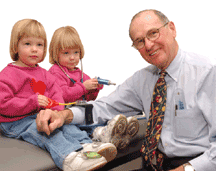C. Edward Hartford, MD
Burn Program Director
with two-year-old twins
Katie and Elizabeth
 Burn Program
Burn Program
The Burn Program at The Children’s Hospital is committed to providing the highest standard of burn care to neonates, infants, children and adolescents up to 21 years of age.
Thermal, chemical and electrical burns are managed during the acute period through the reconstructive phase. The burn team is also consulted for skin injuries such as exfoliative dermatoses (e.g., Stevens-Johnson syndrome), IV infiltrates and traumatic abrasions. The comprehensive treatment program encompasses a broad spectrum of interventions including pain and itching management, wound care, range of motion, nutritional management, emotional support and financial assistance.
Clinical Activities
During 2001-2002, a total of 66 children were admitted to The Children’s Hospital for acute burn injuries. Almost 700 outpatient visits took place in 2001/2002. In addition to children from Colorado, the Burn Center team treated patients from Wyoming, Nebraska, South Dakota and Illinois.
In 2002, severity as measured by total body surface area (TBSA) affected ranged from less than 10 percent (17 inpatients) to greater than 70 percent (one inpatient). The average length of stay was two days. Among outpatients, TBSA affected ranged from less than one percent (53 patients) to 11 percent (two patients).
The burn team works with Therapeutic Recreation/Child Life Specialists to help children cope with dressing changes. As a result, much less sedation is now required. Children with significant wound-care needs are taken to the operating room for dressing changes or first-graft checks.
In addition to direct consults, the burn team manages many incidents by telephone in concert with the child’s primary care physician and/or an outlying medical facility.
Intervention and Outreach Programs
Burn camps for children, young adults and families are conducted through a collaborative effort of The Children’s Hospital Burn Center, the Regions Hospital Burn Center in St. Paul, Minnesota and Shriners Hospital in Galveston, Texas. Marion Doctor, LCSW, coordinates the burn camp programs at Children’s and also chairs the International Association of Burn Camps.
The Burn Center’s Juvenile Firesetter Program, a group treatment program for fire-setting children and their parents, is supported by a grant from the Colorado Department of Juvenile Justice. Seventy children ranging in age from seven to 13 years were referred to the intensive program in 2002. Program leaders are advocating court-ordered treatment for children charged with arson as part of a formal rehabilitation plan.
Numerous tours of Burn Center facilities are offered for high school groups, Colorado legislators and community organizations. The burn team members routinely provide educational lectures to community physician offices on burn care.
Future
As the number of children seen for burn injury decreases—a welcomed decline attributed in part to the success of prevention and education efforts—Children’s has the opportunity to restructure its Burn Center activities. Such efforts are underway at this time.
Cleft Palate Clinic
The Cleft Palate Clinic at The Children’s Hospital is one of the top centers in the country for the treatment of cleft lip and palate, submucous cleft palate, velopharyngeal incompetence, paralysis of the palate and oral-motor coordination problems. The clinic serves a broad geographical area along the eastern Rocky Mountains and Great Plains. In addition to pediatric plastic surgeons, the multidisciplinary team includes pediatric dentists, pediatric otolaryngologists, speech-language pathologists, audiologists, pediatricians, physical therapists and social workers.
An extensive evaluation results not only in surgical and clinical treatment recommendations, but a holistic therapeutic approach. Ongoing therapy for hearing problems, dental oversight, monitoring of breathing and feeding problems, and development of speech and language skills are provided by a specially trained pediatric staff. Family educational programs and community resources are an integral part of the overall treatment plan. Collaboration with a child’s primary care provider or pediatrician ensures a continuum of care for young cleft palate and cleft lip patients.
Neurotrauma Rehabilitation
The Children’s Hospital Neurotrauma Rehabilitation Program provides comprehensive, family-centered services to children who have neurological or musculoskeletal impairments due to traumatic injury, illness or congenital developmental conditions.
The multidisciplinary approach in the Rocky Mountain region’s only pediatric neurotrauma rehabilitation program has produced steadily improving patient outcomes, while simultaneously decreasing the average length of stay for over a decade. The program has some of the best outcomes and one of the shortest average lengths of stay in the nation, despite the trend toward increasingly complex medical and physical diagnoses.
Traumatic brain injury (TBI) is the most common diagnosis for kids in the inpatient neurotrauma rehabilitation unit. This is consistent with the major causes of injury for kids under 10, falls and motor vehicle accidents. Partnering with the hospital’s Level I Pediatric Regional Trauma Center, pediatric surgeons and critical care physicians enables neurotrauma rehab to intervene early in the management of trauma cases, substantially increasing chances of positive outcomes. Infrequently, patients need continued care in an acute unit at The Children’s Hospital or at a hospital closer to home, however almost 95% of the children in the program are released to home each year.
Since 1987, the rehabilitation program has continued to refine a sophisticated measurement tool in assessing patient outcomes. Quantifying success has supported the development of newer and better protocols and promoted leading-edge research into complex neurological diagnoses.

